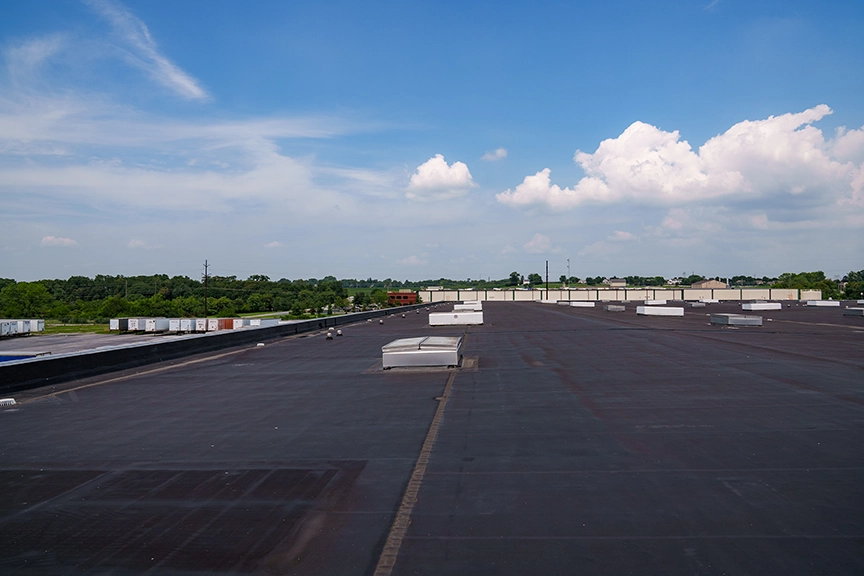Understanding Thermal Cycling Can Preserve Your Commercial Roof
Thermal cycling is the process of repeatedly changing the temperature of a material between two extremes, which can cause thermal stresses in the material.

Understanding thermal cycling will aid in the performance and lifespan of your facility’s roof—especially here in the northeast, where your roof will see a 100-degree temperature fluctuation over its lifetime. Unfortunately, thermal expansion and contraction will have a negative impact on roofing materials and structures by causing materials to move, resulting in component fatigue and wear and tear.
Material Movement
No matter what commercial roof type you have—single-ply, spray foam, metal, or shingle—all components on your roof will move due to thermal expansion and contraction. During hot weather, roofing materials will expand as they absorb heat; and when temperatures drop, the same materials contract as they cool down. This continuous cycle of expansion and contraction puts stress on the roofing system, particularly the seams, joints, and fastenings.
When roofing components shift, roof leaks can occur. Over time, the expansion and contraction cycle can create small openings in the roof membrane, flashings, or anywhere there are roof penetrations, such as skylights or HVAC units. These gaps allow water to seep into a building, leading to leaks and potential damage to the structure or insulation.
If the roof deck itself (the structural base) expands or contracts excessively, it can also cause shifts in the roofing material. This can lead to buckling, warping, or gaps that may damage the surface materials and reduce the roof’s overall structural integrity.
Component Fatigue
In addition to causing roofing materials to move, the second way thermal cycling can impact a commercial roof is by causing component fatigue. Membranes such as TPO, EPDM, and roof flashing, can be particularly impacted by thermal expansion and contraction. When these flexible materials expand and contract, they can weaken the adhesive bonds or fasteners holding them in place. This may lead to roofing membranes becoming loose, wrinkled, or torn.
Flashing is especially vulnerable to movement since it’s used to waterproof joints where the roof meets other structures, such as walls or vents. Thermal expansion can cause the flashing to pull away from these surfaces, creating gaps that allow water infiltration.
Your commercial roof’s fasteners can also experience strain due to thermal cycling. On metal roofs or other types of roofs with mechanical fastening systems, expansion and contraction can result in fasteners becoming loose over time. This is particularly problematic in systems where fasteners penetrate the surface since loosened fasteners can create entry points for moisture.
Wear and Tear
The third way your commercial roof can be affected by thermal expansion and contraction is by causing wear and tear to every part of your roofing system. Cracking and splitting can occur with asphalt and shingles because these materials can become brittle over time due to temperature fluctuations and repeated contraction during freezing weather can result in their shortened lifespan.
Sealants can also be added to the casualty list of wear and tear items. Many roofing systems rely on sealants for waterproofing. However, thermal cycling can cause sealants to crack or become ineffective, leading to water ingress.
The sun is also a contributor to wear and tear on your roof during thermal expansion. Constant exposure to heat and UV rays from the sun can accelerate the aging process of roofing materials, especially those made from organic compounds like rubber or bitumen. As the roof materials expand and degrade, their ability to withstand thermal cycling diminishes, exacerbating the effects of expansion and contraction.
To prevent these three issues—material movement, component fatigue, and wear and tear—from occurring on your commercial roof because of thermal cycling, you should think about enacting the following prevention and mitigation efforts.
- Proper Material Selection: Choosing roofing materials with higher flexibility or elasticity, such as certain types of thermoplastic membranes can help your roofing system to better withstand thermal cycling.
- Adequate Expansion Joints: Installing expansion joints in large roof areas allows for controlled movement, reducing the stress on other parts of your roof.
- Regular Maintenance: Regular commercial roof inspections and maintenance can help catch issues, such as cracks, loose fasteners, or deteriorating seals before they become an emergency roof repair cost.
- Reflective Roof Coatings: Applying reflective coatings can reduce heat absorption, thus minimizing the amount of expansion caused by temperature increases.
If you are not sure where to begin, you can trust the professionals at Capital Roof Care (CRC) to review commercial roof maintenance plans and help you select one that allows your roof to function more effectively and last longer.
By understanding the effects of thermal expansion and contraction, building owners can take steps to ensure their commercial roofs last longer and remain in good condition. And if roof repair or restoration are no longer options due to thermal expansion and contraction, CRC will be able to offer you roof replacement solutions for the long run.
Sources: